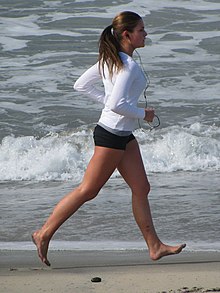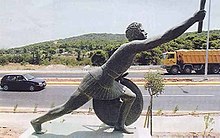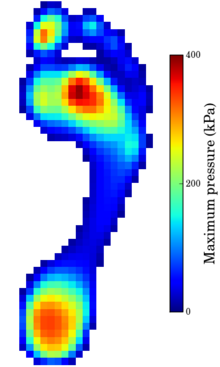Barefoot running

Barefoot running, also called "natural running", is the act of running without footwear. With the advent of modern footwear, running barefoot has become less common in most parts of the world but is still practiced in parts of Africa and Latin America. In some Western countries, barefoot running has grown in popularity due to perceived health benefits.[1]
Scientific research into the practice of running barefoot or with minimalist shoes is increasingly suggesting that it increases intrinsic foot muscle size and strength, but it has been limited to healthy individuals and further research is required to reach definite conclusions.[2] While footwear might provide protection from cuts, bruises, impact and weather, proponents argue that running barefoot reduces the risk of chronic injuries (notably repetitive stress injuries) caused by heel striking in padded running shoes.
The barefoot movement has prompted some manufacturers to introduce minimalist shoes, thin-soled and flexible shoes such as traditional moccasins and huaraches for minimalist running.
History
[edit]
Throughout most of human history, running was performed while barefoot or in thin-soled shoes such as moccasins. This practice continues today in Kenya and among the Tarahumara people of northern Mexico.[3] Historians believe that the runners of Ancient Greece ran barefoot. According to legend, Pheidippides, the first marathoner, ran from Athens to Sparta in less than 36 hours. After the Battle of Marathon, it is said he ran straight from the battlefield to Athens to inform the Athenians of the Greek victory over Persia.[4]

In 1960, Abebe Bikila of Ethiopia won the Olympic marathon in Rome barefoot setting a new world record after discovering that Adidas, the Olympic shoe supplier, had run out of shoes in his size. He was in pain because he had received shoes that were too small, so he decided to simply run barefoot; Bikila had trained running barefoot prior to the Olympics. He would go on to defend his Olympic title four years later in Tokyo while wearing Puma shoes and setting a new world record.[5]
British runner Bruce Tulloh competed in many races during the 1960s while barefoot, and won the gold medal in the 1962 European Games 5,000-metre race.[6]
In the 1970s, Shivnath Singh, one of India's greatest long distance runners, was known for always running barefoot with only tape on his feet.[7]
During the 1980s, a South African runner, Zola Budd, became known for her barefoot running style as well as training and racing barefoot. She won the 1985 and 1986 IAAF World Cross Country Championships and competed in the 1984 Olympic Games in Los Angeles.[7]
Kenyan runner Tegla Loroupe began running barefoot 10 km (6.2 mi) to and from school every day at the age of seven. She performed well in contests at school, and in 1988, won a prestigious cross country barefoot race. She went on to compete, both barefoot and shod, in several international competitions, marathons, and half-marathons. She won the Goodwill Games over 10,000 metres, barefoot, and was the first African woman to win the New York City Marathon in 1994, winning again in 1998.[8]

In the 2000s, barefoot running gained a small yet significant following on the fringe of the larger running community. The practice saw a surge in popularity after the 2009 publication of Christopher McDougall's book, Born to Run, promoting the practice.[9][10] In the United States, the Barefoot Runners Society was founded in November 2009 as a national club for unshod runners and grew quickly.[11]
Health and medical implications
[edit]
Since the latter half of the 20th century, there has been scientific and medical interest in the benefits and harm involved in barefoot running. The 1970s, in particular, saw a resurgent interest in jogging in western countries and modern running shoes were developed and marketed.[12] Since then, running shoes have been blamed for the increased incidence of running injuries and this has prompted some runners to go barefoot.[1]

The structure of the human foot and lower leg is very efficient at absorbing the shock of landing and turning the energy of the fall into forward motion, through the springing action of the foot's natural arch. Scientists studying runners' foot motions have observed striking differences between habitually shod runners (wearing shoes) and barefoot runners. The foot of habitually shod runners typically lands with an initial heel strike, while the foot of a barefoot runner lands with a more springy step on the middle, or on the ball of the foot.[1] In addition, the strike is shorter in duration and the step rate is higher. When looking at the muscle activity (electromyography), studies have shown a higher pre-activation of the plantar flexor muscles when running barefoot.[13] Indeed, since muscles' role is to prepare the locomotor system for the contact with the ground, muscle activity before the strike depends on the expected impact. Forefoot strike, shorter step duration, higher rate and higher muscle pre-activation are techniques to reduce stress of repetitive high shocks.[13] This avoids a very painful and heavy impact, equivalent to two to three times the body weight.[12]
A prospective study from 2019 found that when habituated to barefoot running (for two months with 15 minutes per week of barefoot running), participants exhibited higher vertical loading rates than shod runners, contradicting Lieberman and the asserted injury prevention potential of barefoot running.[14] Another study from 2018 showed that the highest load rates are found in injured heel striking runners.[15]
When comparing different populations of habitually barefoot runners, not all of them favour the forefoot strike. A 2012 study focusing on 38 runners of the Daasanach tribe in Kenya found that a majority of runners favoured a heel strike instead of a forefoot strike.[16]
The longitudinal (medial) arch of the foot also may undergo physiological changes upon habitually training barefoot. The longitudinal arch has been observed to decrease in length by an average of 4.7 mm, suggesting activation of foot musculature when barefoot that is usually inactive when shod. These muscles allow the foot to dampen impact and may remove stress from the plantar fascia.[1] In addition to muscle changes, barefoot running also reduces energy use: oxygen consumption was found to be approximately 4% higher in shod versus barefoot runners. Better running economy observed when running barefoot compared to running with shoes can be explained by a better use of the muscle elasticity. Reduction of contact time and higher pre-stretch level can enhance the stretch shortening cycle behaviour of the plantar flexor muscles and thus possibly allow a better storage and restitution of elastic energy compared to shod running.[17]
The running shoe itself has also been examined as a possible cause of many injuries associated with shod running. It has been found that running in conventional running shoes increases stress on the knee joints up to 38%, although it is still unclear if this leads to a higher rate of heel injuries or not.[18] One study suggests that there is no evidence that cushioning or pronation control in shoes reduces injury rates or reduces performance.[19] Improperly fitting shoes may also result in injuries such as a subungual hematoma, a collection of blood underneath the toenail. This may also be known as "runner's toe" or "tennis toe".[20]
Minimal footwear
[edit]
The alternative to going barefoot is to wear thin shoes with minimal padding. This is what runners wore for thousands of years before the 1980s when the modern running shoe was invented. Shoes, such as moccasins or thin sandals, permit a similar gait as barefoot, but protect the feet from cuts, abrasion and soft sticky matter.[1] The Tarahumara wear thin-soled sandals known as huaraches.[3] These sandals have a single long lace with a thin sole made from either recycled tires, commercially available replacement outsole rubber, or leather. The practice of wearing light or no shoes while running may be termed "minimalist running".[21]
Historically, plimsolls were worn by children in the United Kingdom for physical education classes as well as by soldiers for PT. Inexpensive "dime store" plimsolls have very thin footbeds (3mm elastomer/rubber outsole, 1mm card, 2mm eva foam) and no heel lift or stiffening.[22]
See also
[edit]References
[edit]- ^ a b c d e Francis, Peter; Schofield, Grant (1 April 2020). "From barefoot hunter gathering to shod pavement pounding. Where to from here? A narrative review". BMJ Open Sport & Exercise Medicine. 6 (1): e000577. doi:10.1136/bmjsem-2019-000577. ISSN 2055-7647. PMC 7202747. PMID 32405429.
- ^ Xu, Jennifer; Saliba, Susan A.; Jaffri, Abbis H. (1 May 2023). "The effects of minimalist shoes on plantar intrinsic foot muscle size and strength: A systematic review". International Journal of Sports Medicine. 44 (5): 320–328. doi:10.1055/a-1908-8867. ISSN 0172-4622. PMID 35878616.
- ^ a b Tawa, Nassib; Louw, Quinette (2018). "Biomechanical factors associated with running economy and performance of elite Kenyan distance runners: A systematic review". Journal of Bodywork and Movement Therapies. 22 (1): 1–10. doi:10.1016/j.jbmt.2017.11.004. ISSN 1360-8592. PMID 29332730.
- ^ Christensen, Dirk Lund; Nielsen, Thomas Heine; Schwartz, Adam (2009). "Herodotos and Hemerodromoi: Pheidippides' Run from Athens to Sparta in 490 BC from Historical and Physiological Perspectives". Hermes. 137 (2): 148–169. doi:10.25162/hermes-2009-0010. ISSN 0018-0777. JSTOR 40379088.
- ^ Jahn, Vitória da Silveira; Correia, Clara Knierim; Dell’Antonio, Elisa; Mochizuki, Luis; Ruschel, Caroline (11 December 2020). "Biomechanics of shod and barefoot running: A literature review". Revista Brasileira de Medicina do Esporte. 26 (6): 551–557. doi:10.1590/1517-869220202606219320. ISSN 1517-8692.
- ^ Lorenz, Daniel S.; Pontillo, Marisa (1 November 2012). "Is there evidence to support a forefoot strike pattern in barefoot runners? A review". Sports Health: A Multidisciplinary Approach. 4 (6): 480–484. doi:10.1177/1941738112448055. ISSN 1941-7381. PMC 3497946. PMID 24179586.
- ^ a b Warnock, Carly (2013). Barefoot running: Feeling the world through your feet (Thesis). University of Ottawa. doi:10.20381/ruor-3151. hdl:10393/24398.
- ^ Bridel, William; Denison, Jim; Markula, Pirkko, eds. (5 October 2015). Endurance running: A socio-cultural examination (1 ed.). London: Routledge. doi:10.4324/9781315749518. ISBN 978-1-315-74951-8.
- ^ McDougall, Christopher (2009). Born to run: a hidden tribe, superathletes, and the greatest race the world has never seen. New York: Alfred A. Knopf. ISBN 978-0-307-26630-9. OCLC 318360335.
- ^ Markula, Pirkko (5 October 2015). "Foot trouble: The minimalist running movement". In Bridel, William; Denison, Jim; Markula, Pirkko (eds.). Endurance Running: A socio-cultural examination (1 ed.). Routledge. doi:10.4324/9781315749518-8. ISBN 978-1-315-74951-8.
- ^ Altman, Allison R.; Davis, Irene S. (1 April 2016). "Prospective comparison of running injuries between shod and barefoot runners". British Journal of Sports Medicine. 50 (8): 476–480. doi:10.1136/bjsports-2014-094482. ISSN 0306-3674. PMID 26130697.
- ^ a b Lieberman, Daniel E.; Venkadesan, Madhusudhan; Werbel, William A.; Daoud, Adam I.; D’Andrea, Susan; Davis, Irene S.; Mang’Eni, Robert Ojiambo; Pitsiladis, Yannis (1 January 2010). "Foot strike patterns and collision forces in habitually barefoot versus shod runners". Nature. 463 (7280): 531–535. Bibcode:2010Natur.463..531L. doi:10.1038/nature08723. ISSN 0028-0836. PMID 20111000.
- ^ a b Divert, C.; Mornieux, G.; Baur, H.; Mayer, F.; Belli, A. (1 September 2005). "Mechanical comparison of barefoot and shod running". International Journal of Sports Medicine. 26 (7): 593–598. doi:10.1055/s-2004-821327. ISSN 0172-4622. PMID 16195994. S2CID 42071767.
- ^ Hollander, Karsten; Liebl, Dominik; Meining, Stephanie; Mattes, Klaus; Willwacher, Steffen; Zech, Astrid (1 July 2019). "Adaptation of Running Biomechanics to Repeated Barefoot Running: A Randomized Controlled Study". The American Journal of Sports Medicine. 47 (8): 1975–1983. doi:10.1177/0363546519849920. ISSN 0363-5465. PMC 6604239. PMID 31166116.
- ^ Futrell, Erin E.; Jamison, Steve T.; Tenforde, Adam S.; Davis, Irene S. (1 September 2018). "Relationships between habitual cadence, footstrike, and vertical load rates in runners". Medicine & Science in Sports & Exercise. 50 (9): 1837–1841. doi:10.1249/MSS.0000000000001629. ISSN 1530-0315. PMID 29614001.
- ^ Hatala, Kevin G.; Dingwall, Heather L.; Wunderlich, Roshna E.; Richmond, Brian G. (9 January 2013). Lucia, Alejandro (ed.). "Variation in Foot Strike Patterns during Running among Habitually Barefoot Populations". PLOS ONE. 8 (1): e52548. Bibcode:2013PLoSO...852548H. doi:10.1371/journal.pone.0052548. ISSN 1932-6203. PMC 3541372. PMID 23326341.
- ^ Hanson, N. J.; Berg, K.; Deka, P.; Meendering, J. R.; Ryan, C. (1 June 2011). "Oxygen cost of running barefoot vs. running shod". International Journal of Sports Medicine. 32 (6): 401–406. doi:10.1055/s-0030-1265203. ISSN 0172-4622. PMID 21472628.
- ^ Kerrigan, D. Casey; Franz, Jason R.; Keenan, Geoffrey S.; Dicharry, Jay; Della Croce, Ugo; Wilder, Robert P. (1 December 2009). "The effect of running shoes on lower extremity joint torques". PM&R. 1 (12): 1058–1063. doi:10.1016/j.pmrj.2009.09.011. ISSN 1934-1482. PMID 20006314. S2CID 19281815.
- ^ Richards, C E; Magin, P J; Callister, R (1 March 2009). "Is your prescription of distance running shoes evidence-based?". British Journal of Sports Medicine. 43 (3): 159–162. doi:10.1136/bjsm.2008.046680. ISSN 0306-3674. PMID 18424485.
- ^ Mailler, E A; Adams, B B (1 August 2004). "The wear and tear of 26.2: dermatological injuries reported on marathon day". British Journal of Sports Medicine. 38 (4): 498–501. doi:10.1136/bjsm.2004.011874. ISSN 0306-3674. PMC 1724877. PMID 15273194.
- ^ Ridge, Sarah T.; Standifird, Tyler; Rivera, Jessica; Johnson, A. Wayne; Mitchell, Ulrike; Hunter, Iain (11 August 2015). "The Effect of Training in Minimalist Running Shoes on Running Economy". Journal of Sports Science & Medicine. 14 (3): 643–647. ISSN 1303-2968. PMC 4541130. PMID 26336352.
- ^ Wilkinson, Michael; Ewen, Alistair; Caplan, Nicholas; O'leary, David; Smith, Neil; Stoneham, Richard; Saxby, Lee (1 May 2018). "Textured insoles reduce vertical loading rate and increase subjective plantar sensation in overground running". European Journal of Sport Science. 18 (4): 497–503. doi:10.1080/17461391.2018.1444094. ISSN 1746-1391. PMID 29529927.
